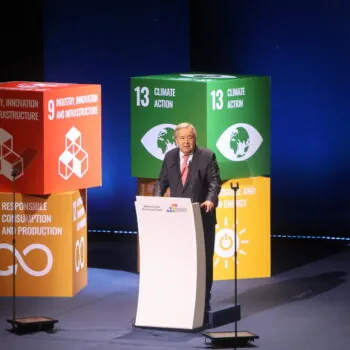The foreword to Banking on Asia is written by Christiana Figueres, former Executive Secretary of the UN Framework Convention on Climate Change (2010 to 2016), and Convenor, Mission 2020.
The world is banking on Asia.
The Asia-Pacific region is at the centre of megatrends that are reshaping the global economy. Heightened perceptions of geopolitical risk, intensifying competition for scarce natural resources, rapid advances in technology and increasing environmental stresses are all drivers of unprecedented change.
In these uncertain times, the countries of the Asia Pacific are facing critical choices about how to plan for their next phase of development. Urgent and massively scaled-up investments are required to meet the demands of young and rapidly urbanizing populations, and to address the growing scourge of air pollution and climate change impacts through a commitment to pursue a new development paradigm that leapfrogs the carbon intensity of the Industrial Revolution, and pivots towards clean, affordable, reliable and sustainable infrastructure and energy for the 21st Century.
Multilateral and bilateral development banks have an important role to play in helping Asian economies and societies prepare to be “fit for the future”. They are key change agents in the transition to a climate-safe global economy for the region and worldwide.
In some cases, these development banks can act as market makers in the global financial system, using their position as knowledge holders to establish norms, set precedents and support lighthouse projects that help to reshape perceptions of what sound and sustainable development should look like. They can both catalyse investment in green economic activity and use de-risking measures to promote an orderly transition to a safe climate future. They can work with governments to build “future proof” infrastructure, and help to redirect large-scale investment to climate-friendly projects and initiatives. And most importantly, they are well-placed to help governments and investors to think and plan for the long-term, making them ideal facilitators of real climate leadership.
Last year, the six banks analysed in this report – the Asian Development Bank, Asian Infrastructure Investment Bank, China Development Bank, Japan International Cooperation Agency, Korea Development Bank and the World Bank Group – together disbursed over USD 1.7 trillion in loans. Among these major lenders and investors, the China Development Bank dwarfs its peers in terms of scale and wields significant power capable of being leveraged to shift financial flows towards sustainable infrastructure.
Multilateral and bilateral development banks also have unique power and influence to catalyse other public and private financial flows in all regions of the world, and none more so than in the rapidly emerging economies of the Asia region. Where they lead, the private sector is more likely to follow, in terms of geographies, technologies and business models.
Asia has huge untapped low- and zero-carbon energy and emissions reduction potential, and its efforts will shape the world’s climate change mitigation response. At the same time, the region is at risk of suffering some of the most severe climate impacts and risks. Investing now in carbon lock-in infrastructure and energy would put in serious jeopardy the goals of the Paris Agreement, particularly in light of recent advice from the IPCC that global emissions need to be halved over the coming decade to keep the door open to the safer limit of stabilizing the world’s climate at 1.5°C above pre-industrial levels. Fatih Birol, the Executive Director of the International Energy Agency, has said that the projected growth of coal-fired power in Asia is concerning because new generation capacity would “lock in the emissions trajectory of the world, full stop.” He added that, “how we are going to deal with this problem is for me the nerve centre of the climate change debate today”.
As institutions responsible for directing billions of dollars of public taxpayer capital, development banks must use their money for the public good, both nationally and internationally. Indeed, they have a responsibility to constantly re-evaluate the impact of their lending activities to ensure they are using this money consistent with public expectations and interests, including growing calls for a more ambitious response to the climate crisis.
At a time when few institutions were lending during the global financial crisis, the MDBs provided USD 222 billion in financing, which was critical to global stabilisation efforts. The climate crisis demands an equivalent or even bolder response. Thankfully, all of the major multilateral and bilateral development banks, including those working in Asia, have committed to align their operations with the Paris Agreement, including its temperature goals. Rapid translation of this global objective into new bank policies, consistent with the joint MDB framework for alignment with the Paris Agreement and International Development Finance Club, is the best next step for ensuring the necessary step-change towards climate-responsible banking. And it would also complement actions being taken in other parts of the financial system to ensure its overall stability in the face of climate challenges and risks, including by the IMF, central banks and financial regulators. At the pointy end of the spectrum is that publicly-financed development banks have a special responsibility not to finance national assets and investments at risk of becoming financially ‘stranded’ as a result of the rapidly accelerating climate transition.
Sound banking for the future requires that the Asian multilateral and bilateral development banks become ‘climate banks’ as quickly as possible. The process of operationalising a complex international agreement like the Paris Agreement into the day-to-day operations of an even more complex bank is neither simple, nor easy. But it must be done, and done quickly. This report illustrates clearly that while there are some signs of progress, none of the development banks active in Asia – including the World Bank and the Asian Development Bank – is yet fully aligned with the Paris Agreement.
Even since the adoption of the Paris Agreement in late 2015, the six institutions covered in this report are estimated to have invested a total of USD 65 billion over 2016 and 2017 in ‘brown’ energy (see Chapter 4 of this report). It is essential that these banks share best practice and harmonise their standards to continually drive up the quality of their investments. While regarded in some quarters as unnecessary “red tape”, standards and safeguards offer an avenue for ensuring that banks are operating on sound principles, and responding to the latest understanding of regional investment needs and risks, including those posed by climate change.
Multilateral and bilateral development banks have a unique opportunity to drive and accelerate the global climate transition. While early alignment of their operations with the Paris Agreement is a necessary first step, the bigger sign of progress would be proactive support for countries developing and then pursuing their own low-carbon development pathways towards a prosperous, resilient and net-zero carbon economy.
Economic growth and prosperity will only be possible and sustainable if climate change causes and impacts are properly managed, and if sound climate management is recognised as essential to sound banking. If all development banks around the world act in accordance with this principle, we will be one big step closer to achieving a socially and historically just and climate-safe planet for generations to come.


